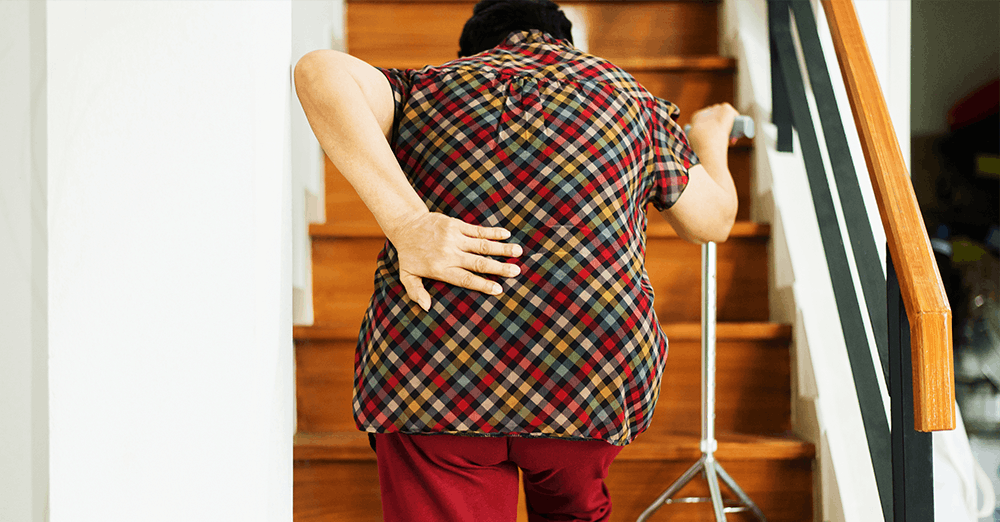What are the Causes and Risk Factors of Osteoporosis?

As bodies grow and develop, bones also change.

In fact, bones are in a constant cycle of growth and degeneration. Young people’s bodies create new bone faster than old bones breaks down, which gradually works to increase bone mass. Beyond the age of 20, the process of bone creations slows, and most people reach their peak bone density somewhere in their 30s. Aging bones generally lose density; the process of breakdown and renewal is still going on, but at a much slower pace. Osteoporosis occurs when growth of new bone is unable to keep pace with the breakdown of old bone, resulting in an overall loss of bone density and mass. X-rays of normal bones show a tight, dense matrix of bone cells. But bones with osteoporosis are largely air; the dense bony matrix has largely dissolved, leaving only sparse thin strands. When osteoporosis is present, bones—especially hips, wrists, and vertebra—break easily, sometimes with as little provocation as a sudden sneeze or cough.
Osteoporosis Risk Factors
Everyone experiences a slowdown in the production of new bone, but not everyone experiences osteoporosis. What causes osteoporosis and who’s at risk for developing this disease?
The leading cause of osteoporosis is, by far, estrogen deficiency in women. Nearly 50% of women experience osteoporosis as they age. Bone loss accelerates after menopause, when women experience a sudden drop in estrogen. But being a postmenopausal woman is certainly not the only risk factor for developing osteoporosis. Remember, osteoporosis presents when bones lose density which occurs either because new bone growth slows or because bone degeneration speeds up. With that in mind, it’s easy to see why the risk factors of osteoporosis are numerous.
Hormones
Low estrogen in women is a significant risk factor, but other hormones also play a role in the growth cycle of bones. These include testosterone, parathyroid hormones, and thyroid hormones. Just like women need estrogen for bone health, men need testosterone. A testosterone deficiency puts men at a higher risk for developing osteoporosis. Parathyroid hormones help direct how well bones use calcium. Too much parathyroid hormone disrupts the absorption of calcium; less calcium means weaker bones. Hyperthyroidism, which is an overactive thyroid, is also associated with bone loss.
Medical Conditions
A number of medical conditions contribute to bone loss. Any disease that directly affects the bones, such as bone cancer or multiple myeloma tumors, will naturally affect the strength and density of bones. However, a number of other conditions indirectly affect the health of bones. One big category of such diseases is gastrointestinal conditions, such as IBS, celiac disease, eating disorders, weight loss surgeries, etc. These conditions all affect the body’s ability to absorb nutrition, and, when nutrients like calcium and vitamin D can’t be absorbed, bones suffer the consequences. Cancer is another category; patients with breast cancer and prostate cancer are likely to experience bone loss. Rheumatoid arthritis, kidney disease, and liver disease are all also associated with osteoporosis. Patients experiencing these conditions need to discuss bone health with their doctor as part of the treatment program.
Medications
Many medications have side effects that weaken bones and can’t result in medication-induced osteoporosis. It’s important to talk to your doctor about any medications you take and their relationship to bone health, especially if you’re at a high risk for osteoporosis. Examples of medicines that can lead to drug-induced osteoporosis include:
Corticosteroids
Long-term use of prednisone and other steroids can contribute to bone loss.
Thyroid Hormones
Underactive thyroids require medication, but too much thyroid hormone can lead to bone loss.
Anti-Seizure Medications
Some anti-seizure medications, including Dilantin, are associated with losing bone strength
Antacids
Antacids that contain aluminum can affect the absorption of calcium.
Lithium
Used to treat bipolar disorder, lithium contributes to bone loss.
Blood Thinners
Medicines such as Heparin and Coumadin can inhibit calcium absorption and slow bone building.
Built-In Factors
Many of the most significant risk factors for osteoporosis are built in and unchangeable, such as sex, race, age, genes, and frame size. Women get osteoporosis at twice the rate of men, and Caucasians and Asians have a higher risk than other ethnic groups of developing it. In addition, bones naturally get weaker with age, osteoporosis runs in families, and small people experience greater rates of osteoporosis because of their small bone size.
Lifestyle
It should come as no surprise that unhealthy lifestyle choices put patients at a higher risk for osteoporosis. These choices include living a sedentary lifestyle, poor nutrition, consuming excess alcohol, and smoking. It’s important not to be sedentary because exercise strengthens bones and muscles and improves balance. Strong bones are less likely to break, strong muscles protect bones, and good balance means fewer falls. A healthy diet filled with essential nutrients, such as vitamin D and calcium, is also critical to maintaining good bone health. Finally, regular consumption of two or more drinks daily increases the risk of developing osteoporosis, and smoking tobacco weakens bones.
Facing the Future with Osteoporosis
Considering the many risk factors and perils to bone health, it’s not hard to understand why millions of aging Americans are living with osteoporosis, but rest assured that living a healthy, happy, productive life with osteoporosis is possible. Practicing healthy habits in conjunction with a medical treatment program can slow bone loss and, in some cases, even strengthen bones over time. In cases where full-time care is needed, caregivers from organizations such as 24 Hour Home Care provide around-the-clock assistance and support. Our caregivers have the right skills to help osteoporosis patients manage their pain and get moving again.
For more information about the services we provide to patients with osteoporosis, visit our website or call to talk to one of our team members.
